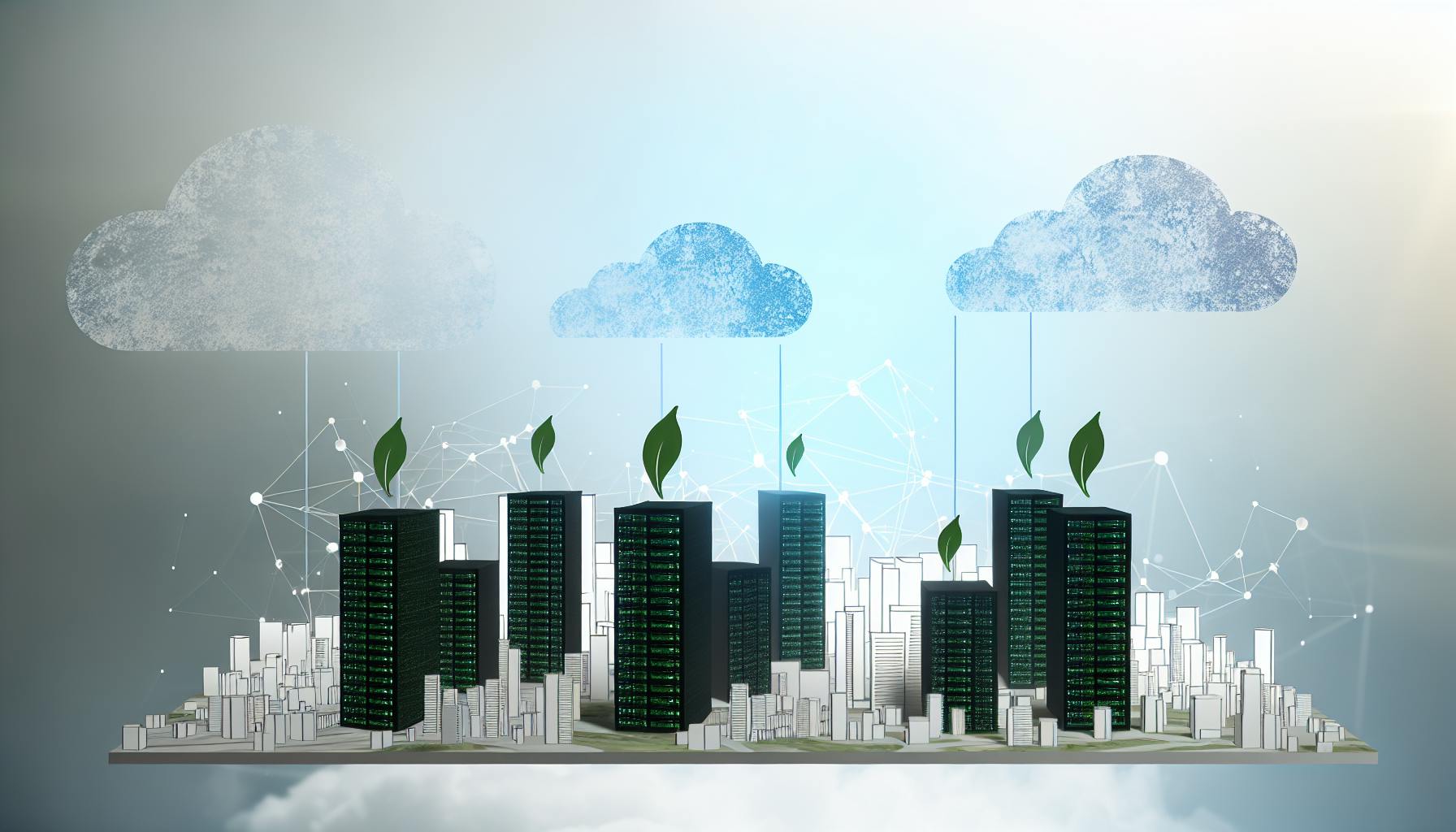Evaluating a business's environmental impact can be a daunting task.
However, new SaaS platforms are emerging that can greatly simplify assessing and managing environmental sustainability issues for companies of any size.
In this article, we'll explore how these solutions utilize automated data collection, benchmarking, and reporting to provide actionable insights into a business's environmental footprint. We'll also look at features like risk identification, compliance tracking, intuitive interfaces, training resources, and integration capabilities that maximize user adoption and real-world impact.
Understanding the Environmental Footprint of Businesses
Business operations can have significant impacts on the environment, from greenhouse gas emissions to waste generation and resource consumption. However, quantifying and managing these impacts can be challenging without the right tools.
Exploring the Scope of Business Environmental Impact on Society
The environmental footprint of a business encompasses:
- Direct impacts - emissions from owned equipment, facilities, vehicles, waste generated, etc.
- Indirect impacts along the supply chain - emissions from purchased goods/services, distribution, etc
- Downstream impacts - emissions from product use, end-of-life disposal, etc
- Impacts on local ecosystems - habitat loss, pollution, invasive species introduction, etc
These collective impacts add up and can substantially degrade environmental quality for communities if not properly managed.
The Shift Toward Environmental Sustainability in Business
In response to growing stakeholder pressures and market shifts, businesses are increasingly prioritizing sustainability through commitments like science-based targets, net zero goals, transparent reporting practices, and responsible supply chain management.
Regulators are also pushing enhanced environmental disclosures like the EU's Corporate Sustainability Reporting Directive (CSRD). Adopting solutions to improve sustainability performance and reporting capabilities is becoming an operational imperative.
Challenges in Assessing Business Environmental Impact
However, assessing environmental impact relies heavily on manual data collection/calculations which is resource-intensive and prone to inconsistencies. This makes accurate and ongoing measurement difficult, especially for small and medium-sized enterprises.
Integrating automated data aggregation from IoT sensors, fleet telemetry, supply chain ERPs etc through SaaS platforms can help businesses access comprehensive, real-time environment insights to aid sustainability performance management.
What type of environment impacts a business?
A business can face impacts from various aspects of its external environment, including:
Economic Environment
- Economic factors like inflation, interest rates, consumer confidence, and access to capital can affect business performance and decisions. For example, during a recession businesses may struggle with reduced consumer spending.
Political & Legal Environment
- Government policies, regulations, tax codes, and trade agreements shape the opportunities and constraints businesses face. Changes in these areas may require businesses to adjust strategies.
Demographic Environment
- Shifts in population size, age distribution, income levels, and other demographic trends shape the composition of potential talent pools and customer bases. Businesses must adapt offerings to evolving demographics.
Competitive Environment
- The number, size, and offerings of rival companies in an industry influence business success. Managers analyze competitor moves and consumer preferences to craft competitive strategies.
Technological Environment
- The pace of technological innovation and disruption, along with consumer adoption of new technologies, alters business processes, products, and service delivery methods. Staying on top of tech trends is key.
Global Environment
- Globalization links companies to expanding opportunities and risks worldwide. Managers must navigate different cultures, languages, laws, supply networks, and economic conditions across borders.
In summary, businesses continually scan political, economic, social, technological, environmental, and legal shifts in the external environment to predict changes, spot threats and opportunities, and adjust internal strategies accordingly. Agility and adaptation are essential to thrive amidst environmental turbulence.
What are environmental risks in business?
Environmental risks in business refer to any potential threats that a company's operations or activities may pose to the natural environment. Some examples of environmental risks that businesses face include:
- Resource scarcity: Overusing natural resources like water, minerals, or forestry materials can deplete supplies and disrupt operations. Businesses rely heavily on these inputs.
- Waste and pollution: Hazardous byproducts from manufacturing, chemical leaks, excessive plastic or paper use can pollute land, air, and waterways. This may lead to compliance issues or reputational damage.
- Climate impacts: Extreme weather events, rising sea levels, warming temperatures can all impact facilities, supply chains, and consumer demand. Proactive climate risk planning is key.
- Biodiversity loss: Deforestation, land-use changes, pollution can accelerate species extinction rates, disrupting ecosystems businesses interact with.
In today's world, managing environmental risks is crucial for companies. It mitigates operational threats, aids legal compliance, boosts brand reputation, and supports environmental sustainability. Adopting preventative measures like conducting environmental impact assessments, installing safeguards against pollution and emissions, using cleaner energy sources, or offsetting environmental damage through ecological restoration projects can help businesses minimize risks and build resilience.
How did big business impact the environment?
Big business practices have had both positive and negative impacts on the environment over time. Here is a brief overview:
Negative Environmental Impacts
- Increased greenhouse gas emissions from industrial activities like manufacturing and energy production. These emissions are a major contributor to climate change.
- Pollution from chemical byproducts released into air, soil, and water systems. This can disrupt ecosystems and endangered species.
- Overuse of natural resources like forests, minerals, etc to produce consumer goods. This leads to depletion and habitat loss.
- Improper waste disposal of non-biodegradable materials such as plastics that accumulate over decades. Ocean and landfill contamination is a huge issue.
Positive Environmental Impacts
- Some businesses have invested heavily in renewable energy infrastructure at scale, helping to transition power grids away from fossil fuels.
- Many companies are committing to ambitious sustainability targets, investing in eco-friendly operations, carbon offsets, and responsible supply chain management.
- Technological innovations spawned by free enterprise have dramatically improved industrial efficiency and environmental performance over the last 50 years.
The business community wields tremendous influence. With conscientious leadership and responsible practices, corporations can drive critical progress on pressing environmental issues. The public and governments are right to demand heightened accountability.
Why is the environment important in business?
The environment plays a crucial role in business success and sustainability. Assessing and managing your business's environmental impact provides many benefits:
- Compliance: Adhering to environmental regulations protects you from costly fines and legal issues. Tracking your emissions and sustainability helps ensure compliance.
- Cost savings: Implementing eco-friendly measures like energy efficiency often saves money over time through lower utility bills.
- Reputation: Customers and investors increasingly support businesses with ethical and green practices. Highlighting your efforts builds goodwill and trust.
- Risk mitigation: Identifying and minimizing environmental risks reduces business disruption from issues like resource scarcity or extreme weather.
- Innovation opportunities: Developing greener products and processes can open new revenue streams and competitive advantages.
In summary, monitoring your environmental impact future-proofs your business model and operations. It demonstrates social responsibility while enabling efficiency and cost savings - delivering tangible value beyond just being the right thing to do. SaaS solutions like EcoHedge provide user-friendly and automated ways to track and improve sustainability performance.
sbb-itb-919600f
The Negative and Positive Impact of Business on the Environment
Businesses can have both positive and negative impacts on the environment. On one hand, some business activities degrade natural habitats, consume resources unsustainably, or pollute ecosystems. However, businesses also have the potential to drive positive change by improving efficiency, investing in renewables, or educating stakeholders.
Business Environmental Impact Examples: The Harmful Effects
Many businesses contribute to issues like climate change, biodiversity loss, and resource depletion. Examples include:
- Manufacturing facilities releasing greenhouse gases and toxic chemicals into the air and water
- Mining projects clearing forests and impacting wildlife
- Consumer brands driving demand for palm oil linked to deforestation
- Data centers consuming vast amounts of electricity
Greater accountability around these issues is important. Tools like carbon accounting software can help businesses understand their environmental footprint.
Positive Impact of Business on Environment: Case Studies
Some businesses make concerted efforts to reduce environmental harm and even regenerate ecosystems. For example:
- IKEA aims to use 100% renewable energy and has invested heavily in wind and solar power
- Interface carpet company has converted manufacturing plants to run on 100% renewables and recycles old carpets into new
- Beauty brand Lush uses minimal packaging, recyclable containers, and ethically-sourced ingredients
Key lessons learned include the viability of low-impact operations, customer demand for eco-friendly brands, and how sustainability and profitability can align.
Assessing Small Business Environmental Impact
Small businesses may have a modest individual footprint but collectively contribute substantially to issues like greenhouse gas emissions and resource usage. For example, the carbon impact of a local print shop's electricity and deliveries adds up.
Streamlined tools specially designed for SMEs can help such businesses understand their environmental impact. This allows small companies to identify "hot spots", set baselines, track progress, engage employees on sustainability initiatives, and communicate achievements to customers.
Harnessing SaaS for Environmental Impact Management
SaaS platforms provide automated solutions to help businesses effectively measure, analyze, and report on their environmental impact. By leveraging cloud-based software, companies can seamlessly integrate sustainability data tracking into day-to-day operations.
Automated Data Collection for Environmental Sustainability Issues
SaaS tools excel at aggregating relevant business environmental impact metrics from across the organization into a centralized database. Built-in connectors pull data from key sources like energy, waste, water, procurement systems and more. Automated data collection eliminates manual processes, ensuring accuracy and saving sustainability teams significant time.
Dashboards give real-time visibility into core metrics like carbon emissions, allowing teams to identify problems areas and negative impact of business on environment. Alerts notify stakeholders when usage or performance thresholds are exceeded, enabling quick action. Overall, SaaS enables proactive environmental management through robust data analysis.
Benchmarking Environmental Performance
In addition to tracking raw sustainability data, leading solutions benchmark performance against industry standards. Graphical dashboards contextualize statistics like emissions intensity, renewable energy utilization and waste diversion rates compared to peers.
Benchmarking uncovers business environmental impact on society by quantifying performance against norms. It flags priority areas for improvement initiatives, supporting more informed strategic decisions to minimize environmental risk in business examples. Comparative analytics help sustainability professionals showcase achievements to leadership and stakeholders.
Streamlined Reporting on Environmental Impact
The best systems go beyond data collection and benchmarking to offer integrated reporting tools aligned with major ESG disclosure frameworks like CDP, GRI and SASB. This simplifies report creation and saves weeks of manual effort for sustainability teams each year.
Reporting automation also facilitates both internal communications and external sharing sustainability tales with customers and investors. More standardized and consistent reporting improves the quality of environmental impact data as well. Overall, integrated reporting enables businesses to efficiently and effectively communicate their climate action progress.
Evaluating Environmental Risk in Business with SaaS
Businesses today face increasing environmental risks that can impact operations and bottom lines. Identifying and mitigating these risks is critical, but can be challenging without the right tools. This is where SaaS platforms can provide invaluable insights.
Identifying Environmental Risk in Business Examples
Common environmental risks businesses face include:
- Supply chain disruptions from climate change events like floods or droughts
- Fines and litigation over pollution incidents or regulatory non-compliance
- Reputational damage and loss of customers from unsustainable practices
SaaS platforms can quickly surface these risks by tracking metrics like:
- Supplier emissions profiles and exposure to climate impact
- Real-time monitoring data of on-site emissions or discharges
- Benchmarking against sustainability standards and regulations
This gives business leaders an accurate picture of current and potential environmental hazards.
Mitigation Strategies Through SaaS Insights
Armed with data-driven risk assessments from SaaS platforms, businesses can develop targeted mitigation strategies such as:
- Diversifying supply chains geographically to minimize climate impact risks
- Upgrading equipment and processes to reduce on-site emissions
- Establishing environmental management systems to ensure regulatory compliance
Ongoing tracking through SaaS tools also allows businesses to monitor the effectiveness of these mitigation efforts.
Compliance Tracking and Regulatory Adherence
By centralizing sustainability data and providing real-time visibility into metrics like carbon emissions or resource usage, SaaS solutions enable businesses to easily track their performance against relevant regulations and standards.
Built-in benchmarking and automated reporting streamlines compliance processes that might otherwise require manual data collection and time-consuming documentation. Proactive alerts on regulatory changes also help businesses adapt quickly and avoid non-compliance.
Ultimately this compliance assurance reduces operating risks significantly over time as sustainability regulations expand.
Maximizing User Engagement and SaaS Utilization
User engagement and utilization are critical for the success of any SaaS platform focused on enabling organizations to measure and manage their environmental impact. An intuitive user experience and seamless integration with existing business systems can greatly influence adoption and usage.
Designing for Intuitive User Experiences
Well-designed dashboards with clear key performance indicators simplify complex sustainability data for business users. Workflow automation and suggestions guide users to take actions for continuous improvement. Embedding training modules and support directly within the platform's interface aids self-service troubleshooting. These UX optimizations make EcoHedge easier to use for individuals at any skill level.
Supporting Users with Training and Resources
EcoHedge University offers a training curriculum covering platform navigation basics to advanced carbon accounting methodology. Short tutorial videos address common use cases. Tiered customer support models - such as email, chat, phone line access - provide assistance tailored to each customer's needs and budget. Proactive guidance helps users gain confidence using the software.
Seamless Integration with Existing Business Systems
EcoHedge's API and connectors allow sustainability insights to be embedded directly into mainstream platforms like ERP, CRM, and BI tools. Automated data flows eliminate manual reporting needs. Environmental KPI dashboards make insights easily accessible to departments company-wide. This facilitates usage while minimizing business disruption during adoption.
Conclusion: Paving the Way for Sustainable Business Practices
Scaling Environmental Action in the SaaS Age
SaaS platforms provide automated tools that can help businesses of all sizes implement environmental best practices. By standardizing sustainability reporting and analysis, these solutions eliminate manual data collection and make it easy for companies to track key metrics like carbon emissions across their operations and supply chain. This enables environmental accountability and impact reduction initiatives to scale efficiently across the long tail of small and medium enterprises.
Measuring Real-world Environmental Outcomes
Too often, sustainability goals focus on lofty theoretical targets that fail to translate into measurable real-world outcomes. SaaS changes this status quo by putting the emphasis on scientific measurement of actual environmental key performance indicators over time. With consistent emissions data and supply chain visibility, companies can benchmark progress, prioritize reductions, and validate the tangible climate and ecological benefits of their actions.
Fostering Innovation and Collaboration for Environmental Impact
The flexibility of SaaS allows platforms to continuously refine features and functionality to meet evolving sustainability needs. With ongoing public-private partnerships and open data standards, these systems can ingest diverse ESG data sources and foster collaborative innovation that drives maximal environmental impact across entire industries. The potential for platforms to enable transparency, accountability, and collective action makes SaaS solutions a pivotal aspect of creating a genuinely sustainable future.



